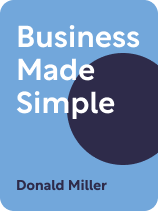

This article is an excerpt from the Shortform book guide to "Business Made Simple" by Donald Miller. Shortform has the world's best summaries and analyses of books you should be reading.
Like this article? Sign up for a free trial here.
What is a sales funnel and how does it work? How can you use a sales funnel to engage customers?
Business and marketing expert Donald Miller says to succeed in business, you must add value to the company, explaining his 11 steps to career success in his book Business Made Simple. In the book, he claims that a sales funnel is the most important part of a marketing strategy.
Read on to learn what a sales funnel is and how it works in marketing, according to Miller.
What Is a Sales Funnel?
According to Donald Miller, the most important element of a marketing strategy is a strong sales funnel. But, what is a sales funnel and how does it work? A sales funnel lets you stay in touch with customers, which builds trust and, eventually, sales. Part of building a sales funnel is learning how to strategize, writes Miller. He defines strategizing as the act of balancing divisions and priorities to maximize company success. The best way to do this is to see your business as an airplane that consists of five distinct parts or divisions: a body (your overhead), wings (your products and services), a right engine (marketing), a left engine (sales), and fuel (capital and cash flow).
Critically, to fly and stay airborne, you must ensure all parts are in the right proportion to each other and support each other. Otherwise, the plane may be too heavy (too much overhead), there might not be enough fuel (not enough capital), or your wings might not be strong enough (your products aren’t popular).
For example, if you want to hire more people and increase the weight of the plane’s body, your engines of marketing and sales must be powerful enough to keep the new weight aloft. You might thus launch a new campaign and increase your sales team’s monthly targets.
Specifically, to stay aloft, Miller recommends keeping overhead low, ensuring your products are both profitable and in demand, creating a marketing test website that lets you refine your messaging and gauge interest, building a sales funnel, and carefully monitoring cash flow.
Now that we know a sales funnel is a part of strategizing in business, we’ll discuss in more detail how a sales funnel works in marketing.
How Does the 3-Step Sales Funnel Work?
According to Miller, a sales funnel works by taking the prospect through three phases: curiosity, understanding, and purchase.
(Shortform note: Though he describes it, Miller doesn’t define what a sales funnel is outright. According to another source, a sales funnel is a representation of a customer’s shift from merely being aware of a product to buying it. In addition to letting you maintain contact and track customers, it also helps you determine a target group of customers so you can focus your efforts. What’s more, you can visualize the sales funnel in different ways than what Miller recommends. For instance, you could view the sales funnel as having four phases: awareness of the product, interaction with the brand (by requesting more information, for instance), continued interest in the product, and action to buy.)
To engage a prospective customer’s curiosity, craft a simple sentence that contains: 1) a problem, 2) the solution that is your product, and 3) the result of solving the problem using your product.
(Shortform note: It’s occasionally unclear in his book where Miller recommends using pitches and marketing materials like the above sentence to pique the customer’s curiosity. Based on Building a StoryBrand, we might infer that he wants you to use such pitches across all marketing platforms and collateral.)
Once the sales funnel has worked to make the prospective customer curious about your product, enhance their understanding of it by explaining how it helps them survive. For instance, you might describe the features of the product and show how these improve the customer’s life. The best way to help the prospect understand your product is through a lead generator. This is a free product you offer—often a PDF, video, or other media—in exchange for your prospective customer’s email address (thus, the product generates a “lead” or new customer for the company). The content of this lead generator must help the prospective customer solve a problem and therefore be of real value to them.
(Shortform note: Miller notes some additional tips in Building a StoryBrand on how to create a great lead generator. First, always give your lead generator a title (for example: “Six mistakes marketers make.” This makes it more interesting and memorable for the reader. Further, have the lead generator appear as a pop-up on your website 10 seconds after the customer opens the page. Finally, don’t be afraid to include more information and value in the lead generator than might feel comfortable at first—it will strengthen trust because you’re helping the customer better understand how the product helps them survive.)
Only once you’ve completed the first two steps of the sales funnel can you ask a customer for a purchase. This is because the first two steps establish a relationship with the customer that generates faith in your product and primes them to buy.
(Shortform note: We can link Miller’s belief about how the sales funnel works—that you must establish a relationship with your customer before asking them to buy—to Malcolm Gladwell’s notion of priming. Priming is the act of exposing someone to a stimulus that prompts a specific response to a later stimulus. In this way, you might prime your customer to buy from your brand by first exposing them to marketing stimuli about your brand that appeal to them.)

———End of Preview———
Like what you just read? Read the rest of the world's best book summary and analysis of Donald Miller's "Business Made Simple" at Shortform.
Here's what you'll find in our full Business Made Simple summary:
- Why you aren’t making as much progress in your career as you’d like
- Why you should see yourself as an investment of your organization
- 11 steps to add value to yourself as an employee






